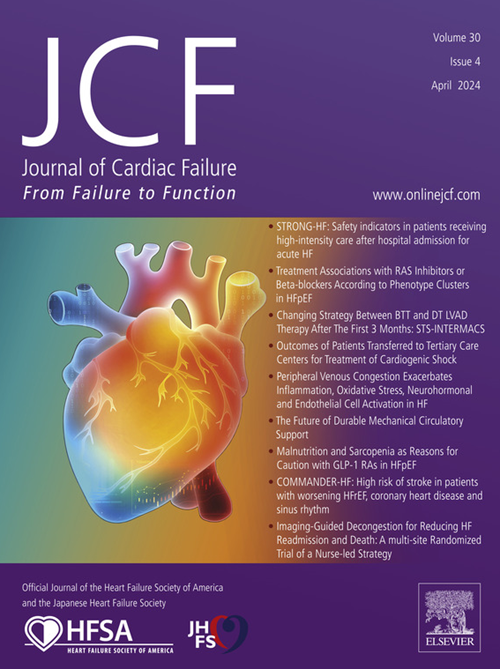开始使用苏比里尔/缬沙坦对HFrEF血液神经变性标志物的影响。
IF 6.7
2区 医学
Q1 CARDIAC & CARDIOVASCULAR SYSTEMS
引用次数: 0
摘要
背景:沙克比利/缬沙坦是治疗心力衰竭伴射血分数降低(HFrEF)的关键药物。然而,由于neprilysin抑制可能影响淀粉样蛋白-β (Aβ)代谢,因此其对认知功能的潜在影响仍然值得关注。本研究评估了苏比里尔/缬沙坦对神经变性血浆生物标志物的影响。方法:采用单分子阵列(SIMOA)技术,在来自biobank前瞻性注册的HFrEF队列中,在基线、3个月和1年后,测量血浆神经标志物,即a β40、a β42、神经丝轻链(NfL)和总tau (t-tau)。对基线与3个月、基线与1年随访进行比较。结果:共纳入31例HFrEF患者(中位年龄:61岁,男性74%,NT-proBNP: 2333 pg/ml)。Aβ40在3个月时短暂升高[228.6 pg/ml (Q1-Q3: 157.8-321.1) vs. 138.8 pg/ml (110.0-202.2), p < 0.001],但在1年后保持不变[215.0 (106.5-290.9),p = 0.052]。a - β42保持稳定[9.90(6.67-12.49)和8.43(5.57-11.86)比7.84 (6.50-11.02)pg/ml, p = 0.108和0.771],导致a - β42/ a - β40比值降低[3个月时0.039 (0.036-0.049),p < 0.001;0.048 (0.041-0.060), p = 0.026 vs. 0.055(0.052-0.061)]。总tau蛋白保持不变[1.13(0.91-1.90)和1.21(0.85-1.65)比1.03 (0.82-1.53)pg/ml, p = 0.068和0.188],而NfL在1年后增加[28.3(16.5-78.6)比22.6 (15.1-46.9)pg/ml, p = 0.013],短期无变化[25.3 (15.0-51.3),p = 0.502]。结论:Sacubitril/缬沙坦治疗HFrEF患者可导致a - β40的短暂升高和a - β42/ a - β40比值的持续降低。稳定的t-tau和短期稳定的NfL水平可以保证没有立即的神经元损伤,而1年后观察到的NfL增加可能表明持续的心力衰竭进展,而不是直接的神经毒性。这些发现强调了在ARNi治疗患者的神经认知评估中对a - β42/ a - β40比值进行谨慎解释的必要性。需要进一步的研究来阐明sacubitril/缬沙坦对HFrEF的长期认知影响。本文章由计算机程序翻译,如有差异,请以英文原文为准。
Effect of Initiation With Sacubitril/valsartan on Blood Neurodegeneration Markers in HFrEF
Background
Sacubitril/valsartan is a key therapy for heart failure with reduced ejection fraction (HFrEF). However, concerns remain regarding its potential impact on cognitive function, because neprilysin inhibition may influence amyloid-β (Aβ) metabolism. This study evaluates the effect of sacubitril/valsartan on plasma biomarkers of neurodegeneration.
Methods
Plasma neuromarkers (i.e., Aβ40, Aβ42, neurofilament light chain [NfL], and total tau [t-tau]) were measured at baseline, 3 months and 1 year after sacubitril/valsartan initiation by using the single-molecule array (SIMOA) technology in a cohort with HFrEF from a prospective registry with Biobank. Comparisons were made for baseline vs 3-month and baseline vs 1-year follow-up.
Results
A total of 31 patients with HFrEF (median age: 61 years, 74% male, median NT-proBNP level: 2333 pg/mL) were included. Aβ40 increased transiently at 3 months (228.6 pg/mL [Q1–Q3: 157.8–321.1] vs 138.8 [110.0–202.2]; P < 0.001) but remained unchanged at 1 year (215.0 [106.5–290.9]; P = 0.052). Aβ42 remained stable (9.90 [6.67–12.49] and 8.43 [5.57–11.86] vs 7.84 [6.50–11.02] pg/mL; P = 0.108 and 0.771), resulting in a reduced Aβ42/Aβ40 ratio at both follow-ups (0.039 [0.036–0.049] at 3 months, P < 0.001; 0.048 [0.041–0.060] at 1 year, P = 0.026; vs 0.055 [0.052–0.061]). Total tau remained unchanged (1.13 [0.91–1.90] and 1.21 [0.85–1.65] vs 1.03 [0.82–1.53] pg/mL; P = 0.068 and 0.188), while NfL increased at 1 year (28.3 [16.5–78.6] vs 22.6 [15.1–46.9] pg/mL; P = 0.013), with no short-term change (25.3 [15.0–51.3]; P = 0.502).
Conclusion
Sacubitril/valsartan therapy in patients with HFrEF leads to a transient increase in Aβ40 and a sustained reduction in the Aβ42/Aβ40 ratio. Stable t-tau and short-term stable NfL levels provide reassurance regarding the absence of immediate neuronal injury, while an NfL increase observed at 1 year may indicate ongoing progression of heart failure rather than direct neurotoxicity. These findings highlight the need for cautious interpretation of the Aβ42/Aβ40 ratio in neurocognitive assessments among patients treated with angiotensin receptor-neprilysin inhibitors. Further studies are warranted to clarify the long-term cognitive implications of sacubitril/valsartan in patients with HFrEF.
求助全文
通过发布文献求助,成功后即可免费获取论文全文。
去求助
来源期刊

Journal of Cardiac Failure
医学-心血管系统
CiteScore
7.80
自引率
8.30%
发文量
653
审稿时长
21 days
期刊介绍:
Journal of Cardiac Failure publishes original, peer-reviewed communications of scientific excellence and review articles on clinical research, basic human studies, animal studies, and bench research with potential clinical applications to heart failure - pathogenesis, etiology, epidemiology, pathophysiological mechanisms, assessment, prevention, and treatment.
 求助内容:
求助内容: 应助结果提醒方式:
应助结果提醒方式:


